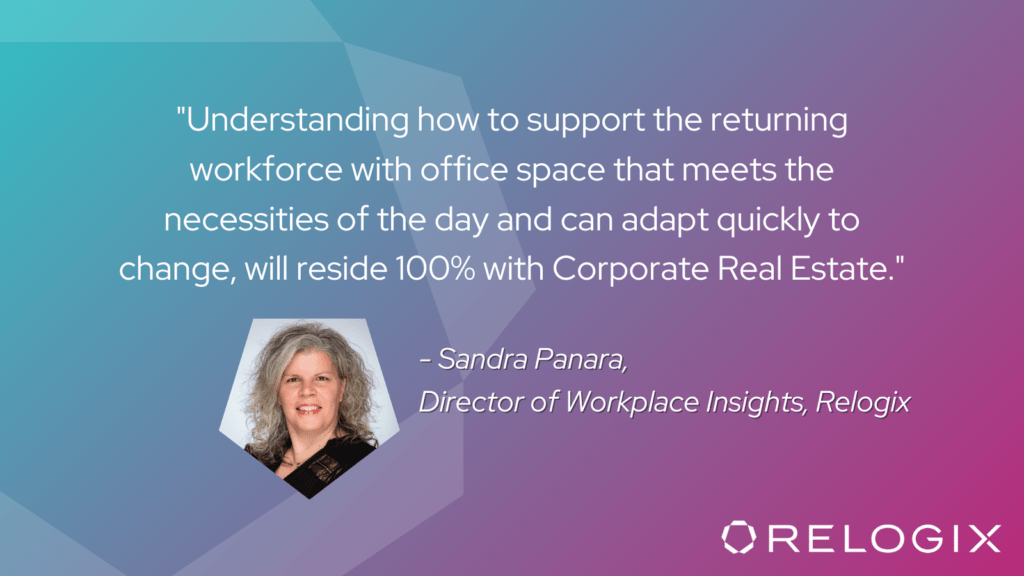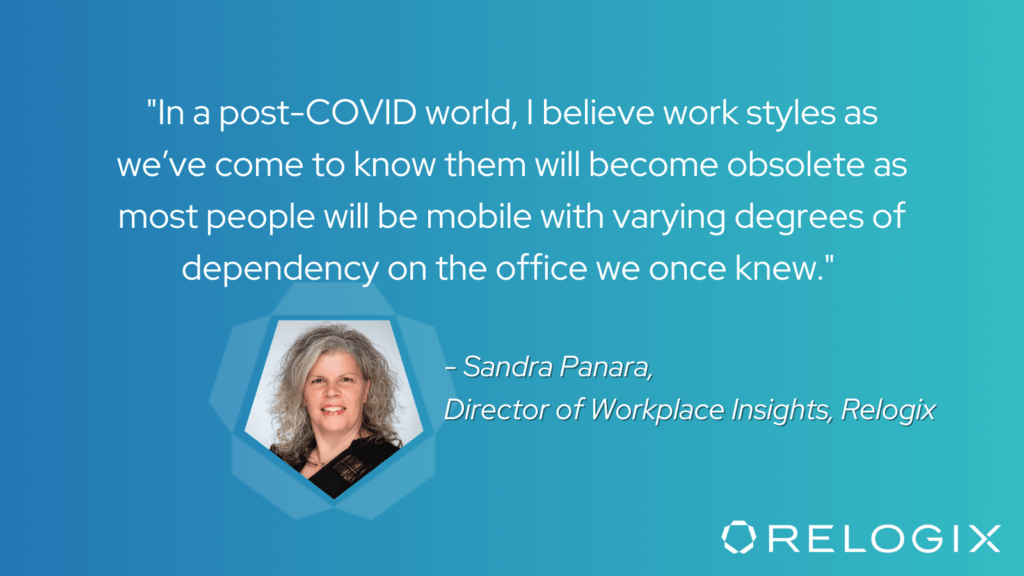Change and Opportunity in A Disrupted Corporate Real Estate World
While we may be starting to return to the office and students are now back at school, this is anything but a “return to normal”. In so many ways, our lives flipped upside down and going back to the way things were before the pandemic is impossible at this point. As our priorities, values, and perspectives change, we need to question if we even need to return to the way things were.
Understanding how to support the returning workforce with office space that meets the necessities of the day and can adapt quickly to change, will reside 100% with Corporate Real Estate.

Many of the predominant trends we see now in office behaviour are trends that were gaining traction before COVID-19. For example:
- Flexibility with where and when we work
- Growing preference for corporate cultures that revolve around brand equity
- Transparent communication and trust
- Emphasis on wellness in the workplace
These are not new. If anything, COVID accelerated their foothold into the fabric of our lives, with Corporate Real Estate as the hardest hit in the world of work. The challenges of figuring out who needs to be where, when, and how often, will be a concerted effort across individual organizations.
Gallup panel data shows that in the US, 41% would prefer to return to their workplace or office to work, as they did before the crisis.
Gensler’s Work from Home Survey 2020 shows that only 12% of U.S. workers want to work from home full-time.

It is impossible to predict what the in-office experience will look and feel like. We could all return to work in the office one day or we could choose to continue to work from home. Both exist as equal possibilities. It is also possible that workplaces will become a hybrid of locations – an ecosystem of work settings that responds to our immediate needs.
Regardless, the demand for office space will continue but the challenge will be to address the disparities. We have engaged in a worldwide work from home experiment, including inequities based on income, where we live, how we get to and from work, gender, and age. To be successful in our ever-changing world, we need to account for the diversity, equity and inclusivity that will define business success moving forward.
“At the moment, we’re at home because we’re stuck there. But when we aren’t in the midst of a global health crisis, there are different reasons to want the ability to work remotely, or outside of standard hours.” – New York Times
In the past, companies approached flexibility from the standpoint of how they could make physical spaces allow for different activities. Now, our existing CRE environments need more than a change in furniture placement and shared amenity spaces. With the shift to remote work, we are seeing a corresponding shift in previous assumptions that working from home equates to lower engagement or productivity.
How we define productivity is changing, as is the belief that good work is the result of work done in the office. COVID is providing the opportunity to align the CRE portfolio with values that blend the best of remote work practices with physical spaces that reflect a new way of thinking about where, how and when we work.
In our present ambiguity, we need to prepare to respond as people’s expectations change by baking flexibility into our policies, processes, and frameworks today. We need to be open to the fact that one-size does not fit all. We need to dismantle what we believe to make way for reality. We need to aim at driving better outcomes through new ways of thinking and, most importantly, new ways of doing.
Even companies with the most office-centric cultures pre-pandemic will need to accept that the return to office will look different for everyone due to a growing need for flexibility that did not exist previously. Because flexibility means different things to different people, we need to keep the definition of “flexibility” flexible too.
What we need is the transformation of our CRE spaces through a shift in the way we define the purpose of our offices and our perception of what it means to have flexibility in how we work. As our values change, our workplaces need to change along with them.
Questioning Traditional Assumptions to Introduce New Thinking
In pre-COVID times, organizations believed that, “occupancy analytics for space utilization sought to maximize the number of people in a space ensuring occupant health, wellbeing, and productivity.” While one may argue that utilization analysis and insights gained popularity as foundational to informing workplace strategy, cramming people into a space has rarely been the goal of any of the global Fortune 500 clients I’ve worked with over the years.
Densification strategies do happen in organizations. Typically, it happens when organizations grow rapidly and/or merge with another company and need to be able to absorb the added headcount. Whether it is effective is questionable, but one thing is for certain: space utilization data is rarely observed in density driven exercises nor is it a consideration.
When organizations choose to densify their space, all they need to know is the maximum occupancy allowable by building code per floor. That’s it. From there on, it becomes a short-sighted furniture reconfiguration and planning exercise, with little to no long-term strategy involved.
Executed strategically, occupancy analytics maximizes the reduction of square footage and real estate costs. It aligns real estate requirements with the natural behaviours of employees, supporting on-going business growth without increasing the overall real estate portfolio. Identifying and quantifying the degree of flexibility demonstrated by employees is a significant ‘Aha’ moment in understanding the power of workspace occupancy and utilization analytics.
Flexibility is measured by combining insights on:
- Frequency and duration of meetings attended both in-person and in the office
- Frequency of inter-office visits
- Movement that happens between floors in a building.
This approach appreciates that people are not tethered to their desks. It presents an opportunity to explore how the office could better support the ways in which people individually shape their days as they work. Pre-COVID, many organizations considered assigning a proposed work style to employees to manage space reduction initiatives.
In a post-COVID world, I believe work styles as we’ve come to know them will become obsolete as most people will be mobile with varying degrees of dependency on the office we once knew.

As we respond to the changing needs of the workforce because of the pandemic, it is imperative that we examine why things need to change through a different lens. While it is important to address aspects of design, such as the physical distancing to keep people safe and healthy, we can also look at this as an opportunity. We can re-examine and re-define the needs of a changing workforce that proved that working remotely is possible. Since it’s inevitable that we will be working in offices and remotely, we can begin to make the cultural shifts our organizations require to address the workforce as individuals.
Stay tuned for my next post. We’ll explore how CRE professionals can navigate their way back to the office post-COVID through strategies that respond to current return to office challenges and identify ways we can build resiliency into our strategies for the indefinite future.
If you would like to learn more about creating a unique, data-based narrative that fits your organization – register for our Data Stories and Corporate Real Estate seminar series.

